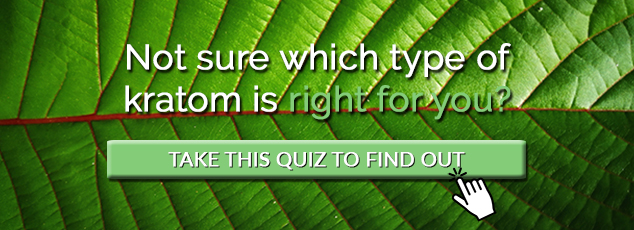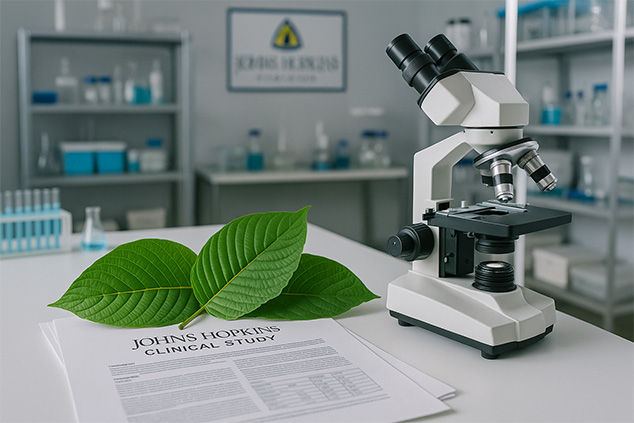Kratom studies are scarce. As a result, finding reliable and unbiased information on the herb is relatively hard. Many sources refer to kratom as a dangerous drug, and there have even been efforts to ban it on the federal level.
While kratom is legal in most states in the US, many locations are still debating its legality and reviewing options for either banning or regulating it.
Since kratom still remains unregulated in most areas, the risk of it being contaminated or adulterated remains rather hard. This has led to unfortunate instances such as the CDC attributing nearly 100 deaths to kratom, when, in actuality, most cases had other substances present and others had inconclusive results or prior health issues.
Luckily, more studies are being done, which will hopefully shed more light on kratom, its alkaloids, and its effects. One such study was led by John Hopkins University School of Medicine.
But, first off…
What Is Kratom?
Kratom, also named Mitragyna speciosa, is a tree indigenous to the jungles of Southeast Asia. The leaves of this tropical tree are rich in alkaloids and other highly beneficial compounds such as flavonoids and polyphenols.
Mitragynine and 7-hydroxymitragynine are the most abundant of the kratom alkaloids and attribute most of its properties.
Kratom has a variety of effects that depend on the vein type and strain, as well as the dosage that you take. In small doses, kratom has energizing and cognition-enhancing effects. However, in higher doses, it becomes a potent analgesic with sedating and relaxing effects.
Mitragyna speciose alkaloids affect the same regions in the brain as opioids. Therefore, many mistakenly refer to kratom as an opioid. While 7-mitragynine is around 13 times more potent than the pain-relieving drug morphine, kratom 8-Factor analysis has proven that Mitragyna speciosa does not have the same dangerous abusee potential.
The Basics of the John Hopkins Kratom Study
John Hopkins University School of Medicine conducted this study using a survey. It examined the responses of over 2,700 respondents who take kratom. 61% of them were female, and the median age was 40. 84% of all respondents had some form of a college education.
Their purpose was to determine the effectiveness of kratom as well as whether its use has less harm than opioid use.
While the results of this kratom study were purely anecdotal, considering the fact the lack of scientific research on the herb, it is still a highly beneficial scientific insight into Mitragyna speciosa.
The Results of the John Hopkins Kratom Study
The kratom study performed by John Hopkins University found out the following:
- 91% of respondents found kratom effective for pain relief,
- 67% of all respondents found the herb to be effective for anxiety,
- 65% found it effective for depression,
- 41% of respondents were taking kratom for opioid withdrawal,
- 87% of those taking kratom for opioid dependence found it effective,
- 35% of respondents who took kratom for opioid addiction reported being off prescription opioids or heroin for over a year.
In addition to the beneficial effects of Mitragyna speciosa, the study also looked at its side effects. The respondents had to complete a Substance Use Disorder checklist as part of the survey. The results found the following:
- Fewer than 3% of all respondents had moderate to severe kratom use disorder,
- Fewer than 10% met the criteria for mild kratom use disorder,
- 5% of respondents experienced kratom withdrawal,
- Only 1.9% of responded experienced severe side effects such as irritability, anxiety, insomnia, or depression.
- 19% experienced mild kratom side effects.
In the meantime, approximately 80% of those taking opioid medication experience at least one side effects. These include dry mouth, constipation, sweating, weight gain, sleep problems, drowsiness, memory issues, appetite loss, sexual dysfunction, nausea, fatigue, dry skin, and dizziness.

Conclusions and Comments from Organizers
Albert Garcia-Romeu, PhD., who instructs psychiatry and behavioral sciences at the John Hopkins University School of Medicine and who lead the team performing this kratom study, commented that the findings of this study do not warrant kratom being categorized as a Schedule I drug. According to him, kratom doesn’t belong in the category.
Moreover, he added that kratom has very low abuse potential and should be explored for medical application as a means of managing pain as well as opioid use disorders.
He also noted that there is a lot of fearmongering due to the opioid-like effects of kratom and the growing concerns and issues caused by the opioid epidemic.
Garcia-Romeu also compared the statistics for opioid deaths and deaths attributed to kratom. He pointed out that in 2017 alone, there were over 47,000 opioid overdose deaths in the united states while, in a relatively similar time period, the CDC attributed nearly 100 deaths to kratom, out of which most had the presence of other substances while others had preexisting health conditions.
Regarding the side effects that kratom use can result in, Garcia-Romeu pointed out that most of that is due to the lack of regulations and standards in the kratom industry. These can result in kratom contamination with dangerous substances or inadequate kratom dosage.
Other Studies on Kratom
In addition to this kratom study, a longer and more thorough study on Mitragyna speciosa is currently in progress at the University of Florida College of Pharmacy. NIDA has granted Christopher McCurdy, the pioneer in kratom studies, and his team nearly $7 million to study the herb.
John Hopkins Kratom Study Takeaways
This kratom study concluded that kratom use is not only significantly less harmful than opioid use but also effective. However, it is crucial to be responsible for kratom and purchase it only from reputable vendors to avoid any contamination. In addition to that, one should be mindful of their kratom dosage and not increase it over time, which can result in tolerance, side effects, and possibly withdrawal.
Are you taking Mitragyna speciosa? Would you agree with the results of this kratom study? How has your experience with the herb been?



Leave a Reply